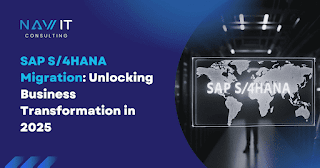SAP S/4HANA Migration: Unlocking Business Transformation in 2025
As the 2027 end-of-support deadline for SAP ECC looms, businesses are prioritizing migration to SAP S/4HANA to stay competitive and future-ready. This next-generation ERP, built on the in-memory HANA database, offers unparalleled speed, agility, and innovation. This blog explores why migration is critical, key challenges, and actionable steps for a successful transition, all tailored for 2025’s dynamic business landscape.
Why Migrate to SAP S/4HANA?
SAP S/4HANA redefines enterprise resource planning with real-time processing and simplified architecture. Key drivers for migration include:
End of ECC Support: SAP ECC support ends in 2027, with extended support until 2030 at a premium. Migration ensures compliance, security, and access to new features.
Performance Boost: The HANA database accelerates data processing, enabling real-time analytics for faster decision-making.
Streamlined Operations: Simplified data models, like the Universal Journal, reduce complexity and enhance efficiency across finance, logistics, and more.
Innovation Enablement: S/4HANA supports AI, machine learning, and IoT, driving predictive insights and automation.
Modern User Experience: SAP Fiori’s intuitive interface improves productivity and user adoption.
Migrating now positions businesses to leverage these benefits and avoid disruptions.
Challenges in S/4HANA Migration
While the rewards are significant, migration presents challenges:
Data Migration: Cleansing and transforming large datasets from ECC to S/4HANA is complex, risking errors if not handled meticulously.
Custom Code Overhaul: Legacy customizations often require rework to align with S/4HANA’s architecture.
Change Management: New processes and Fiori’s interface demand robust user training to ensure adoption.
Cost and Planning: Migration involves licensing, infrastructure, and consulting costs, requiring careful budgeting.
Business Continuity: Poorly managed migrations can disrupt operations during cutover.
Addressing these challenges with a clear strategy is essential for success.
Strategic Migration Approaches
Businesses can choose from three migration paths:
Greenfield: A fresh implementation, ideal for reengineering processes but time-intensive.
Brownfield: Converts ECC to S/4HANA, preserving existing configurations for faster deployment but retaining legacy complexities.
Hybrid: Selectively migrates data and processes, balancing innovation and continuity.
The choice depends on business goals, system complexity, and resources. Tools like SAP Readiness Check aid in assessing the best fit.
Steps for a Successful Migration
Assess and Plan: Use SAP tools to analyze ECC landscapes, define objectives, and create a roadmap.
Prepare Data: Cleanse and map data using SAP Data Services to ensure accuracy.
Adapt Systems: Upgrade ECC to a compatible version, adjust custom code, and verify add-on compatibility.
Execute Conversion: Use Software Update Manager (SUM) for database and application migration, followed by rigorous testing.
Train and Deploy: Train users on Fiori and new processes, execute a smooth cutover, and provide post-go-live support.
Best Practices
Start early to avoid rushed timelines.
Partner with experienced SAP consultants.
Prioritize data quality and user training.
Leverage SAP tools like SUM and Maintenance Planner.
Monitor post-migration performance for continuous improvement.
Conclusion
Migrating to SAP S/4HANA in 2025 is a strategic move to unlock innovation, efficiency, and scalability. By addressing challenges with careful planning and expert support, businesses can transform their ERP systems and thrive in a digital-first world. Act now to ensure a seamless transition before the 2027 deadline.


Comments
Post a Comment